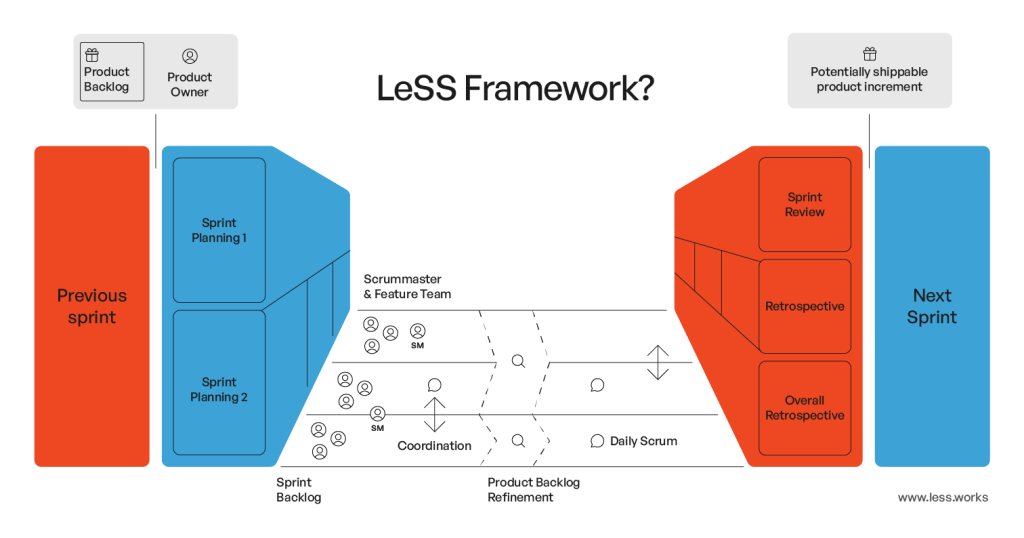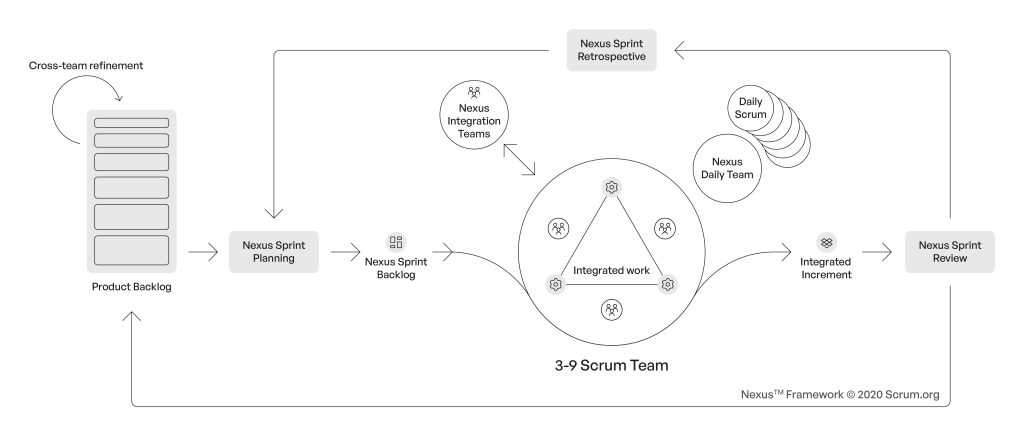When scaling Scrum for multiple teams, organizations often choose between frameworks like LeSS and Nexus. Both offer unique approaches to managing larger product development efforts while staying true to Scrum principles. This article explores the key features, core principles, and differences between LeSS vs Nexus for scaling Scrum efficiently.
LeSS Framework
Key features
Large-Scale Scrum (LeSS) is a framework designed by Craig Larman and Bas Vodde to extend Scrum to multiple teams working on the same product. LeSS scales Scrum while staying true to its core principles of simplicity and flexibility and allows Scrum to be applied across multiple teams, typically ranging from 2 to 8 teams in the standard version. For larger organizations with more than 8 teams, LeSS Huge is used, allowing teams to manage complex, large-scale products while still adhering to LeSS principles.

Core Principles of LeSS
LeSS is built on multiple key principles, most importantly: minimalism, simplicity in scaling, and direct communication.
Minimalism ensures that LeSS adds as few roles, processes, or artifacts as possible beyond basic Scrum, allowing teams to focus on delivering value without unnecessary complexity. Instead of adding management layers to handle multiple teams, LeSS emphasizes scaling down by promoting self-managing teams that collaborate without extra hierarchy. The Just Talk principle encourages informal, direct communication between teams, avoiding over-reliance on formal meetings. This approach accelerates problem-solving and improves collaboration.
Specific Events: Sprint Planning and Overall Retrospectives
In LeSS, Sprint Planning is divided into two parts to manage the coordination of multiple teams. In Sprint Planning Part 1, all teams meet with the Product Owner to review the shared Product Backlog and allocate tasks, ensuring alignment and preventing overlap. Sprint Planning Part 2 is conducted separately by each team, where they focus on the details of how to implement their chosen backlog items, following traditional Scrum planning. Additionally, an Overall Retrospective brings all teams together to reflect on their individual retrospectives and to assess how they collaborate on the product as a whole.
Scaling with LeSS Huge: Managing More Than 8 Teams
For organizations with more than 8 teams, LeSS Huge comes into play. In LeSS Huge, teams are organized into Requirement Areas, which function as mini product areas with their own backlogs and Product Owners, but still one overall PO. This structure allows large-scale organizations to maintain focus on the product while ensuring that individual teams can still operate efficiently and autonomously.
Even though LeSS Huge introduces more structure, it continues to follow LeSS’s emphasis on minimalism and self-organization, avoiding the addition of unnecessary roles or processes.
Why LeSS Stands Out in Scaling Scrum
LeSS is a unique approach to scaling Scrum, offering simplicity and flexibility in a world where other frameworks often introduce complexity. With its focus on minimalism, self-managing teams, and direct communication, LeSS allows organizations to scale without losing the agility and responsiveness that make Scrum successful. Whether scaling to 2 teams or 20, LeSS provides a lean, effective way to manage product development across multiple teams while staying true to Scrum’s core values.
Nexus Framework
Key features
Nexus is a framework designed by Ken Schwaber to scale Scrum for product development involving 3-9 teams, focusing on integration and coordination. Nexus remains lean by maintaining core Scrum principles and addressing the challenges of team integration.

Core Principles of Nexus
A key feature of Nexus is the Integration Team, which ensures that the work of different teams is correctly combined throughout the Sprint. This team focuses on resolving inter-team dependencies and ensuring that all contributions result in a cohesive product increment. This focus on continuous integration is a unique strength of Nexus compared to other frameworks that may emphasize broader system-level integration.
Key Events in Nexus: Additional Daily Scrum and Integration
Nexus also introduces an Additional Daily Scrum for representatives from each Scrum team to address integration issues and dependencies. This meeting supplements, but does not replace, the individual teams’ Daily Scrum, ensuring constant communication and quick issue resolution between teams.
Another unique aspect is the Nexus Sprint Backlog, which visualizes the dependencies between teams and helps coordinate their efforts. This backlog provides transparency into each team’s work and how it aligns with the collective product goals, ensuring smoother integration of deliverables.
Scaling with Nexus: Managing 3-9 Teams Effectively
In summary, Nexus is distinct because of its integration-focused approach, its limit of 3-9 teams, and the continuous coordination it fosters through the Integration Team, additional Daily Scrum, and Nexus Sprint Backlog. By keeping these processes simple yet effective, Nexus excels at maintaining product cohesion without adding excessive complexity.
Nexus, on the other hand, keeps the focus on integration and delivering a working product increment, ensuring that the scaled effort remains lean and effective.
Why Choose Nexus for Scaling Scrum
In summary, Nexus stands out among scaled agile frameworks due to it’s a solution for 3-9 teams, the Integration Team for solving inter-team issues, the additional Daily Scrum for Nexus representatives, the Nexus Backlog that manages dependencies, and its integration-focused nature. Unlike other frameworks that add complexity through multiple layers, Nexus remains closely aligned with Scrum principles while providing the necessary tools to scale effectively. By focusing on integration at every step, Nexus ensures that the teams work together toward delivering a cohesive product increment, making it a compelling choice for scaling Scrum in a lean and focused manner.
LeSS vs Nexus
Key Differences in Scaling Scrum Frameworks
| Less | Nexus |
| LeSS 2-8 – LeSS Huge 9+ Teams | 3-9 teams |
| Simplicity, transparency, agility, team empowerment | Integration Team to solve integration issues between teams |
| Less meetings less new roles | Additional Daily for the nexus team representatives |
| Just talk approach, Communities | Nexus Backlog that visualizes dependencies between teams |
| Own responsibility focused | Integration Focused |
When to use which Framework
LeSS
LeSS is the simplest framework, adding the fewest roles and meetings to Scrum. For smaller projects with fewer Scrum teams, LeSS is a good option. However, it works best when team members are experienced in Scrum and self-organization, as the framework relies heavily on individual responsibility.
Nexus
Choose Nexus over LeSS if your teams frequently face integration issues. Nexus highlights these problems through the Nexus Backlog and addresses them with the Nexus Integration Team. This team, along with the framework’s strong focus on integration, is especially helpful for teams with limited experience in Scrum or scaled Scrum frameworks, keeping them aligned and on track.
Curious to learn more ? Discover our other insights: LeSS vs Nexus Explained